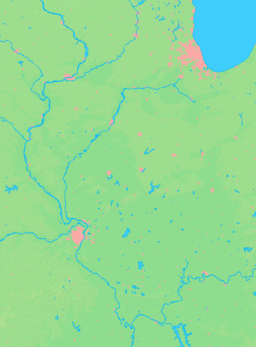Marshall, Illinois
| Marshall | |
| City | |
 Downtown Marshall | |
| Motto: "Thru The Years With Pride"[1] | |
| Country | United States |
|---|---|
| State | Illinois |
| County | Clark |
| Coordinates | 39°23′34″N 87°41′37″W / 39.39278°N 87.69361°WCoordinates: 39°23′34″N 87°41′37″W / 39.39278°N 87.69361°W |
| Area | 3.74 sq mi (10 km2) |
| - land | 3.72 sq mi (10 km2) |
| - water | 0.02 sq mi (0 km2) |
| Population | 3,933 (2010) |
| Density | 1,202.7/sq mi (464/km2) |
| Founded | 1835 |
| Mayor | Camie Sanders |
| Timezone | CST (UTC-6) |
| - summer (DST) | CDT (UTC-5) |
| Postal code | 62441 |
| Area code | 217 |
  Location of Marshall within Illinois | |
| Wikimedia Commons: Marshall, Illinois | |
| Website: City of Marshall, Illinois | |
Marshall is a city in Clark County, Illinois, United States, located about 20 miles (32 km) west of Terre Haute, Indiana. The population was 3,933 at the 2010 census. It is the county seat of Clark County.[2]
History
Marshall was officially organized by William B. Archer in 1835, eight years after the National Road entered the community.[3] The city was named after John Marshall, chief justice of the U.S. Supreme Court.[4] Marshall was incorporated on May 14, 1873.[5]
In 1863, Marshall was the scene of conflict in which local Copperheads, who opposed the Civil War, sought to protect soldiers who had deserted from the Union Army. In March, 1863, an army detail from Indiana arrested several deserters. A local judge, Charles H. Constable, freed the deserters and ordered the arrest of two Union sergeants on kidnapping charges. This resulted in the dispatch of 250 soldiers under the command of Col. Henry B. Carrington by special train from Indianapolis, who surrounded the courthouse, freed the sergeants and arrested judge Charles H. Constable. The judge was, however, absolved several months later after presenting a highly technical defense.[6]
Marshall was home to the Handy Writers' Colony, 1950-1964. The most famous writer associated with the Colony was the novelist James Jones, who built a home in Marshall and lived there ca. 1952-1957.
Geography
Marshall is located at 39°23′34″N 87°41′37″W / 39.39278°N 87.69361°W (39.392848, -87.693627).[7]
According to the 2010 census, Marshall has a total area of 3.736 square miles (9.68 km2), of which 3.72 square miles (9.63 km2) (or 99.57%) is land and 0.016 square miles (0.04 km2) (or 0.43%) is water.[8]
Demographics
| Historical population | |||
|---|---|---|---|
| Census | Pop. | %± | |
| 1880 | 1,885 | — | |
| 1890 | 1,900 | 0.8% | |
| 1900 | 2,077 | 9.3% | |
| 1910 | 2,569 | 23.7% | |
| 1920 | 2,222 | −13.5% | |
| 1930 | 2,368 | 6.6% | |
| 1940 | 2,758 | 16.5% | |
| 1950 | 2,960 | 7.3% | |
| 1960 | 3,270 | 10.5% | |
| 1970 | 3,468 | 6.1% | |
| 1980 | 3,379 | −2.6% | |
| 1990 | 3,555 | 5.2% | |
| 2000 | 3,771 | 6.1% | |
| 2010 | 3,933 | 4.3% | |
| Est. 2015 | 3,880 | [9] | −1.3% |

.jpg)
As of the census[11] of 2000, there were 3,771 people, 1,655 households, and 1,002 families residing in the city. The population density was 1,202.7 people per square mile (463.7/km²). There were 1,832 housing units at an average density of 584.3 per square mile (225.3/km²). The racial makeup of the city was 98.33% White, 0.29% African American, 0.13% Native American, 0.16% Asian, 0.11% Pacific Islander, 0.13% from other races, and 0.85% from two or more races. Hispanic or Latino of any race were 0.48% of the population.
There were 1,655 households out of which 28.3% had children under the age of 18 living with them, 45.2% were married couples living together, 12.0% had a female householder with no husband present, and 39.4% were non-families. 35.7% of all households were made up of individuals and 17.3% had someone living alone who was 65 years of age or older. The average household size was 2.21 and the average family size was 2.87.
In the city the population was spread out with 23.7% under the age of 18, 8.0% from 18 to 24, 26.7% from 25 to 44, 19.8% from 45 to 64, and 21.9% who were 65 years of age or older. The median age was 39 years. For every 100 females there were 84.4 males. For every 100 females age 18 and over, there were 80.9 males.
The median income for a household in the city was $33,413, and the median income for a family was $42,909. Males had a median income of $31,108 versus $21,144 for females. The per capita income for the city was $19,851. About 3.6% of families and 6.2% of the population were below the poverty line, including 6.6% of those under age 18 and 5.5% of those age 65 or over.
Economy
The downtown district is centered on the county courthouse, and includes a number of antique shops. The town's major employer, TRW Automotive, operates an automotive electronics manufacturing facility, employing a thousand area residents. Marshall is the site of the oldest continually operated hotel in Illinois, the Archer House.
Arts and culture
Every autumn Marshall holds a Fall Festival.
The Marshall post office contains an oil on canvas mural, Harvest, painted in 1938 by Miriam McKinnie. Murals were produced from 1934 to 1943 in the United States through the Section of Painting and Sculpture, later called the Section of Fine Arts, of the Treasury Department.
Government
The City of Marshall City Council consists of nine members: eight aldermen and the mayor. Current officeholders are: Camie Sanders, Mayor (term expires 2017); Cheryl Raisner, Alderman Ward 1 (term expires 2017); Tim Sanders, Alderman Ward 1 (term expires 2015); Vickie Wallace, Alderman Ward 2 (term expires 2017); Beverly Church, Alderman Ward 2 (term expires 2015); Jim McKittrick, Alderman Ward 3 (term expires 2017); Warren LeFever, Alderman Ward 3 (term expires 2015); Cathy Macke, Alderman Ward 4 (term expires 2017); Mark Strait, Alderman Ward 4 (term expires 2015); John Trefz, City Clerk; and Larry Woodard, City Treasurer.[12]
Notable people
- Robert H. Birch, American western outlaw, raised in Marshall
- Ed Carpenter (racing driver), IndyCar Series driver, 2013 Indy pole sitter; born and raised in Marshall
- Charles H. Constable, Attorney, Illinois State Senator, Judge, and real estate entrepreneur; close friend of Abraham Lincoln; lived in Marshall[13]
- Ed Mayer, third baseman in Major League Baseball for the Philadelphia Phillies; born in Marshall[14]
- Gerald Forsythe, businessman and auto racing magnate; owner of Forsythe Championship Racing; born in Marshall
- James Jones, novelist, lived in Marshall ca. 1952-1957
- John W. Lewis, Jr., politician; born in Marshall[15]
- John Scholfield, jurist and state legislator; lived in Marshall[16]
- Jacob Zimmerman, United States Representative, newspaper editor, and businessman; lived in Marshall
References
- ↑ "City of Marshall, Illinois". City of Marshall, Illinois. Retrieved August 31, 2012.
- ↑ "Find a County". National Association of Counties. Retrieved 2011-06-07.
- ↑ Marshall from the National Road Association Of Illinois website
- ↑ "Profile for Marshall, Illinois, IL". ePodunk. Retrieved August 31, 2012.
- ↑ "Marshall, Illinois". City-Data.com. Retrieved August 31, 2012.
- ↑ Stephen E. Towne, "'Such conduct must be put down' -- The Military Arrest of Judge Charles H. Constable during the Civil War", Journal of Illinois History, vol 9, no. 1, Spring 2006, p. 43
- ↑ "US Gazetteer files: 2010, 2000, and 1990". United States Census Bureau. 2011-02-12. Retrieved 2011-04-23.
- ↑ "G001 - Geographic Identifiers - 2010 Census Summary File 1". United States Census Bureau. Retrieved 2015-12-27.
- ↑ "Annual Estimates of the Resident Population for Incorporated Places: April 1, 2010 to July 1, 2015". Retrieved July 2, 2016.
- ↑ "Census of Population and Housing". Census.gov. Retrieved June 4, 2015.
- ↑ "American FactFinder". United States Census Bureau. Retrieved 2008-01-31.
- ↑ City Council from the city's website
- ↑ Towne, Stephen E. (2006). Journal of Illinois History (PDF). Indiana University Purdue University Indianapolis.
- ↑ "Ed Mayer". Baseball-Reference.com. Retrieved August 31, 2012.
- ↑ 'Illinois Blue book 1971-1972, Biographical Sketch of John W. Lewis, pg. 45
- ↑ 'Scholfield Dead,' The Argus (Illinois Wesleyan University), February 14, 1893
External links
- City of Marshall, Illinois Website
- Marshall History at GenealogyTrails.com
- City-Data.com